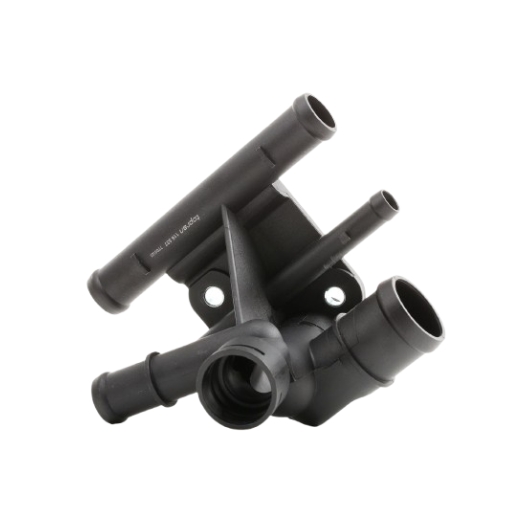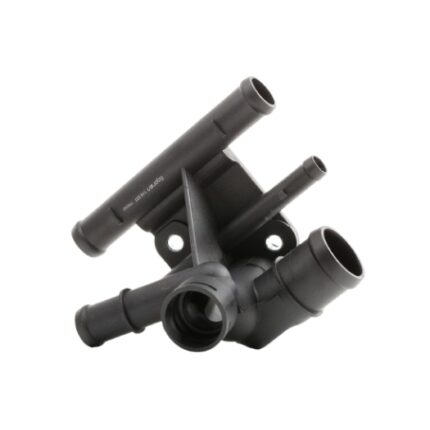Get VW Eos 1F Coolant Flange 06F121132G in Kenya
The coolant flange is a crucial component within an automotive engine’s cooling system. While it may appear as a simple piece of hardware, its role is vital in ensuring the proper distribution and flow of coolant throughout the engine, helping to maintain optimal operating temperatures. This detailed exploration of the coolant flange will cover its function, design, benefits, common issues, and maintenance.
1. Function and Role of the Coolant Flange
A coolant flange acts as a junction point within the engine’s cooling system. It connects various hoses and pipes that circulate coolant between the engine, radiator, and other components like the heater core. The primary function of the coolant flange is to secure these connections, ensuring that coolant flows efficiently without leaks, maintaining the engine’s temperature stability.
Coolant flanges are typically mounted on the engine block or cylinder head and often house sensors or additional components like temperature gauges or pressure release valves. They serve as connection points for multiple coolant pathways, directing the flow of coolant to critical areas within the engine. By ensuring a secure connection between different parts of the cooling system, the coolant flange helps prevent leaks, which could otherwise lead to overheating or coolant loss.
2. Design and Construction
Coolant flanges are typically made from materials such as aluminum, plastic, or a combination of metal and rubber. The choice of material depends on the specific requirements of the vehicle and the operating conditions.
- Aluminum Flanges: These are often used in high-performance or heavy-duty engines due to their strength and resistance to high temperatures. Aluminum flanges are durable and can withstand the harsh conditions within an engine bay, including exposure to high temperatures and corrosive substances.
- Plastic Flanges: Common in many modern vehicles, plastic coolant flanges are lightweight and cost-effective. Advances in plastic materials have allowed for the development of flanges that can endure the heat and pressure found in modern engines. However, plastic flanges may be more prone to cracking or warping over time, especially if exposed to extreme temperatures or if the cooling system is not properly maintained.
- Metal and Rubber Combinations: Some coolant flanges combine metal for strength and rubber for flexibility and sealing. These designs offer the benefits of both materials, providing a durable yet flexible connection point that can absorb some movement and vibration without leaking.
Coolant flanges often feature multiple ports to accommodate various hoses and sensors. The design of the flange ensures that these connections are secure and leak-free, even under the pressure of a running engine. Some flanges also include built-in gaskets or O-rings to further enhance the seal between the flange and the engine block or cylinder head.
3. Benefits of the Coolant Flange
- Leak Prevention: A properly functioning coolant flange ensures that the connections between hoses and the engine block are secure, preventing coolant leaks. Leaks can lead to a loss of coolant, resulting in overheating and potential engine damage.
- Efficient Coolant Flow: The coolant flange plays a crucial role in directing coolant to where it is needed most. By ensuring a smooth and unobstructed flow of coolant, the flange helps maintain consistent engine temperatures, contributing to optimal performance and fuel efficiency.
- Temperature Regulation: Some coolant flanges are equipped with temperature sensors or thermostats, allowing them to monitor and regulate engine temperature more effectively. This ensures the engine operates within its optimal temperature range, preventing both overheating and running too cold.
- Durability: Coolant flanges, especially those made from aluminum or reinforced plastic, are designed to withstand the harsh conditions of the engine bay. They are resistant to corrosion and heat, ensuring long-term reliability.
- Ease of Replacement: In the event of a failure, coolant flanges are typically easy to replace. Their location on the engine block or cylinder head is usually accessible, and replacement parts are widely available, making it a straightforward repair job.
4. Common Issues and Failures
Like any component within an engine, the coolant flange can experience wear and tear over time, leading to potential issues:
- Cracking or Warping: Plastic coolant flanges, in particular, are susceptible to cracking or warping due to prolonged exposure to heat and pressure. Cracks can lead to coolant leaks, which, if left unaddressed, can cause overheating and engine damage.
- Leaking Seals: The gaskets or O-rings used to seal the connection between the flange and the engine block can degrade over time. This can result in coolant leaks, especially if the flange is not securely fastened or if the gasket material has become brittle.
- Corrosion: Metal coolant flanges, particularly those made from aluminum, can corrode over time, especially if the coolant is not maintained properly. Corrosion can weaken the flange, leading to leaks or even complete failure of the component.
- Clogged Passages: Over time, debris, sediment, or rust can build up within the coolant system, leading to clogged passages within the flange. This can restrict coolant flow, causing uneven cooling and potentially leading to overheating.
- Sensor Failures: If the flange houses sensors or other electronic components, these can fail due to exposure to heat, moisture, or vibration. A failed sensor can lead to inaccurate temperature readings, affecting the performance of the cooling system.
5. Maintenance and Replacement
Proper maintenance of the coolant flange is essential to ensure the longevity and efficiency of the engine’s cooling system:
- Regular Inspections: Regularly inspecting the coolant flange for signs of wear, cracks, or leaks is essential. Look for any visible damage or signs of coolant around the flange, which could indicate a leak.
- Coolant System Maintenance: Keeping the coolant system in good condition helps prevent issues with the flange. This includes regularly checking and replacing the coolant, ensuring it is clean and free of debris, and maintaining the correct coolant mixture to prevent corrosion.
- Replacing Gaskets and Seals: Over time, the gaskets or seals within the coolant flange can degrade. Replacing these seals during routine maintenance can help prevent leaks and prolong the life of the flange.
- Timely Replacement: If a coolant flange shows signs of cracking, warping, or significant corrosion, it should be replaced promptly. Delaying replacement can lead to more severe issues, including engine overheating and potential engine damage.
- Choosing the Right Replacement Part: When replacing a coolant flange, it’s important to choose a part that matches the specifications of your vehicle. Using a high-quality replacement part that is designed for your engine ensures a proper fit and reliable performance.
6. Importance in Modern Engines
As engines have become more complex and efficient, the role of the coolant flange has also evolved. In modern engines, where precise temperature control is crucial for meeting emissions standards and achieving optimal performance, the coolant flange plays an even more critical role.
For instance, in engines with turbocharging or advanced emission control systems, maintaining the correct coolant flow and temperature is essential for preventing overheating and ensuring that the engine operates efficiently. The coolant flange, by providing a secure connection point for various coolant passages, helps to maintain this delicate balance.
Follow us on Facebook for more parts.




